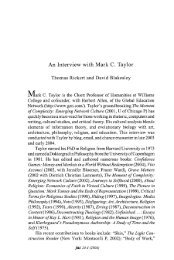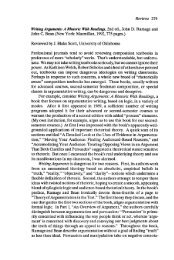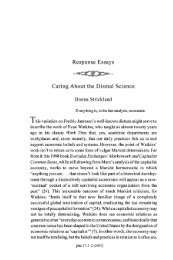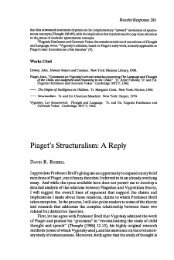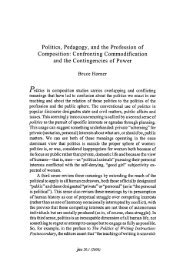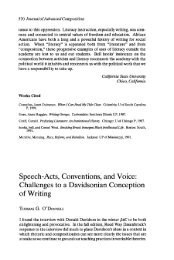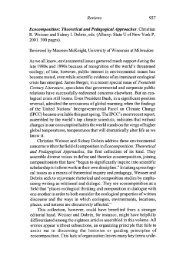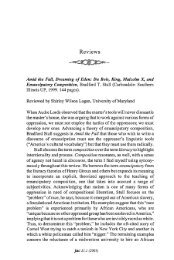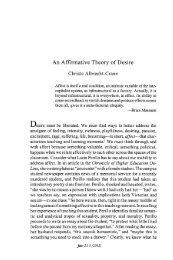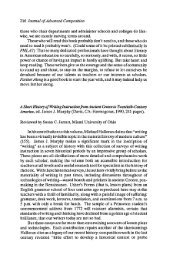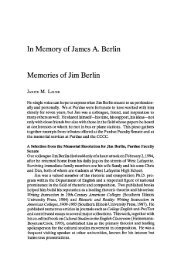Rhetoric in the Classical Tradition by Winifred Bryan ... - JAC Online
Rhetoric in the Classical Tradition by Winifred Bryan ... - JAC Online
Rhetoric in the Classical Tradition by Winifred Bryan ... - JAC Online
Create successful ePaper yourself
Turn your PDF publications into a flip-book with our unique Google optimized e-Paper software.
Reviews 203<br />
pedagogically useful articles that have been published <strong>in</strong> composition <strong>in</strong> this<br />
country <strong>in</strong> <strong>the</strong> last twenty-five years." How <strong>the</strong>y determ<strong>in</strong>ed what or whom<br />
to select and omit, how <strong>the</strong>y decided on <strong>the</strong>ir system of classification, we must<br />
determ<strong>in</strong>e ourselves. The editors expla<strong>in</strong> only that <strong>the</strong>y' 'eased <strong>the</strong> difficulty<br />
of mak<strong>in</strong>g choices <strong>by</strong> adopt<strong>in</strong>g some ra<strong>the</strong>r arbitrary guidel<strong>in</strong>es": <strong>the</strong>y<br />
limited <strong>the</strong> number of articles on each subject and <strong>the</strong> number of articles <strong>by</strong><br />
one author, excluded excerpts from whole books, and occasionally chose an<br />
article because it had never been anthologized.<br />
This lack of historical context is particularly disturb<strong>in</strong>g given <strong>the</strong> target<br />
population of readers: gmduate students and novice teachers. They, especially,<br />
need to understand our history and how this text is, at least tacitly, one<br />
history of <strong>the</strong> field. Those of us who have been around for <strong>the</strong> past decade or<br />
so have a decided advantage: we can' 'read" some of <strong>the</strong> history between <strong>the</strong><br />
l<strong>in</strong>es--<strong>the</strong> stops and starts, <strong>the</strong> fads and flourishes ofT -units, heuristics, new<br />
and old rhetoric, revision, collabomtive learn<strong>in</strong>g, and writ<strong>in</strong>g across <strong>the</strong> curriculum.<br />
We know <strong>the</strong> centers of "<strong>in</strong>fluence." But <strong>the</strong> novice who knows<br />
none of this needs a more explicit <strong>in</strong>troduction to <strong>the</strong> history (<strong>in</strong>deed, <strong>the</strong><br />
histories) of <strong>the</strong> past twenty-five years. This version of Sourcebook dehistoricizes<br />
and decontextualizes our history of <strong>the</strong> past twenty-five years. It does<br />
not take <strong>in</strong>to account, for example, <strong>the</strong> social climate that gave rise to basic<br />
writ<strong>in</strong>g programs or how <strong>the</strong>y subsequently fell, only to be replaced, <strong>in</strong> many<br />
situations, <strong>by</strong> <strong>the</strong> unchecked rise of test<strong>in</strong>g and evaluation.<br />
What we do, how and why we do it, is largely determ<strong>in</strong>ed <strong>by</strong> social and<br />
political forces. A "sourcebook" should provide access to some of those<br />
sources that shape our pedagogies, <strong>the</strong>ories, and <strong>the</strong>ir underly<strong>in</strong>g ideologies.<br />
It seems to me that <strong>in</strong> edit<strong>in</strong>g such a collection, <strong>the</strong> editors <strong>the</strong>mselves must<br />
come forward and clearly articulate <strong>the</strong>ir positions, <strong>the</strong>ir agenda, <strong>the</strong>ir<br />
purposes, <strong>the</strong>ir conception of "<strong>the</strong> writ<strong>in</strong>g teacher." Here is <strong>the</strong> gap that<br />
needs to be filled, <strong>the</strong> k<strong>in</strong>d of history-<strong>the</strong> k<strong>in</strong>d of sources-that all writ<strong>in</strong>g<br />
teachers need to know. Perhaps Tate and Corbett will confront such issues <strong>in</strong><br />
a third edition.<br />
<strong>Rhetoric</strong> <strong>in</strong> <strong>the</strong> <strong>Classical</strong> <strong>Tradition</strong>, W<strong>in</strong>ifred <strong>Bryan</strong> Homer (New York: St.<br />
Mart<strong>in</strong>'s, 1988,462 pages).<br />
Reviewed <strong>by</strong> William A. Cov<strong>in</strong>o, University of Ill<strong>in</strong>ois at Chicago<br />
In recent years, prom<strong>in</strong>ent philosophers, rhetoricians, and literary critics<br />
have reassessed <strong>the</strong> relevance of classical rhetoric to modem pedagogy,<br />
presented compet<strong>in</strong>g versions of classical <strong>the</strong>ory, and recast classical rhetoric<br />
<strong>in</strong> postmodem critical <strong>the</strong>ory. Clearly, <strong>the</strong> time is right for a textbook that
204 Journal of Advanced Composition<br />
takes <strong>in</strong>to account <strong>the</strong>se new understand<strong>in</strong>gs and broadened conceptions of<br />
classical rhetoric, once def<strong>in</strong>ed ma<strong>in</strong>ly <strong>in</strong> terms of <strong>the</strong> formulaic Ad Herennium.<br />
Unfortunately ,Professor Homer has decided not to write that book. She<br />
does, however, give students her understand<strong>in</strong>g of <strong>the</strong> relationship between<br />
standard classical terms and <strong>the</strong> standard elements of modem academic<br />
writ<strong>in</strong>g-an understand<strong>in</strong>g that offers students "a vocabulary for talk<strong>in</strong>g<br />
about writ<strong>in</strong>g," along with practice, examples, and read<strong>in</strong>gs.<br />
The twenty-page "Introduction to <strong>Classical</strong> <strong>Rhetoric</strong>" that beg<strong>in</strong>s <strong>the</strong><br />
book presents two major uses forrhetoric <strong>in</strong> Antiquity: (I) as a demonstration<br />
of <strong>the</strong> "duty of world citizenship," and (2) as <strong>the</strong> "road to wealth, power, and<br />
<strong>in</strong>fluence. " The debate over whe<strong>the</strong>r rhetoric is a moral force or a tool of<br />
personal ambition cont<strong>in</strong>ues today, and Homer seems to respect both sides:<br />
she says, on <strong>the</strong> one hand, that "through rhetoric, we must cont<strong>in</strong>ue to<br />
exam<strong>in</strong>e moral values and to question right and wrong," and on <strong>the</strong> o<strong>the</strong>r, that<br />
"it was [and is] noth<strong>in</strong>g less than imperative for anyone who aspired to a<br />
position of <strong>in</strong>fluence to learn ... <strong>the</strong> art of rhetoric" (4,2). Thus, Homer's<br />
<strong>in</strong>troduction recalls <strong>the</strong> discussion begun <strong>by</strong> Callicles and Socrates <strong>in</strong> <strong>the</strong><br />
Gorgias; she asks students to understand that "skill with spoken and written<br />
language still br<strong>in</strong>gs power" (2), while <strong>the</strong>y consider <strong>the</strong> different k<strong>in</strong>ds of<br />
power that rhetoric can afford.<br />
Throughout <strong>the</strong> text, Homer <strong>in</strong>troduces potentially unfamiliar terms<br />
associated with classical rhetoric (such as Gorgias, hypocrisis, <strong>in</strong>ventio),<br />
along with <strong>the</strong>ir correct pronunciation. These terms are fur<strong>the</strong>r def<strong>in</strong>ed <strong>in</strong> a<br />
glossary, illustrat<strong>in</strong>g Homer's contention that an "acqua<strong>in</strong>tance with classical<br />
rhetoric and <strong>the</strong> great philosophers who conceived it is part of literacy <strong>in</strong><br />
its fullest sense" (xi). This association of literacy with <strong>the</strong> <strong>in</strong>culcation of a<br />
canonical lexicon recalls classical Roman school<strong>in</strong>g, certa<strong>in</strong>ly, and it also<br />
enters <strong>the</strong> current debate about "cultural literacy" on <strong>the</strong> E.D. HirschI Allan<br />
Bloom side.<br />
<strong>Rhetoric</strong> <strong>in</strong> <strong>the</strong> <strong>Classical</strong> <strong>Tradition</strong> is divided <strong>in</strong>to five parts, correspond<strong>in</strong>g<br />
to <strong>the</strong> canons of Roman rhetoric: <strong>in</strong>vention, arrangement, style, memory,<br />
and presentation. The largest section (seven chapters) treats <strong>in</strong>vention and<br />
<strong>in</strong>cludes an <strong>in</strong>terest<strong>in</strong>g emphasis that will be less apparent to writ<strong>in</strong>g students<br />
than to teachers who identify <strong>in</strong>vention with exploration and discovery.<br />
Homer does not feature <strong>in</strong>vention-as-exploration, as Aristotle does <strong>in</strong> <strong>the</strong><br />
<strong>Rhetoric</strong>, choos<strong>in</strong>g <strong>in</strong>stead <strong>the</strong> Roman identification of <strong>in</strong>vention with<br />
organization or arrangement that we f<strong>in</strong>d <strong>in</strong> <strong>the</strong> Ad H erennium and <strong>the</strong> more<br />
formulaic works of Cicero. For <strong>in</strong>stance, <strong>in</strong> <strong>the</strong> first of two chapters on<br />
"Discover<strong>in</strong>g Ideas," Homer presents "def<strong>in</strong>ition" as "<strong>the</strong> organiz<strong>in</strong>g<br />
pr<strong>in</strong>ciple of a full-length essay" (89); she presents "classification and<br />
division" as "ways of clarify<strong>in</strong>g a subject for a reader" (99), and equates<br />
<strong>the</strong>m with partitio, which is-as Homer says elsewhere {ll}-also a Roman<br />
canon of arrangement. The read<strong>in</strong>gs that conclude both chapters on <strong>the</strong> topics<br />
of <strong>in</strong>vention present <strong>the</strong> topics as <strong>the</strong> organiz<strong>in</strong>g pr<strong>in</strong>ciples of f<strong>in</strong>ished
Reviews 205<br />
discourse. After this substantial attention to <strong>in</strong>vention as arrangement, Horner<br />
follows <strong>the</strong> Ad Herennium <strong>by</strong> keep<strong>in</strong>g quite brief (about twenty pages) <strong>the</strong><br />
section explicitly devoted to arrangement<br />
At times, Homer's attempts to propose correspondences between classical<br />
rhetoric and modem writ<strong>in</strong>g seem imprecise or forced. For <strong>in</strong>stance, <strong>in</strong> a<br />
chapter <strong>in</strong> <strong>the</strong> section on <strong>in</strong>vention, she presents description and narration as<br />
modem forms of "<strong>in</strong>artistic proof," after expla<strong>in</strong><strong>in</strong>g that, for Aristotle,<br />
artistic proof comes from "outside sources." Thus, because description and<br />
narration record outside events, <strong>the</strong>y are modem species of <strong>in</strong>artistic proof. It<br />
is probably more accurate to def<strong>in</strong>e Aristotle's <strong>in</strong>artistic proof as evidence<br />
unmediated <strong>by</strong> rhetorical strategy. It follows that description and narration<br />
are certa<strong>in</strong>ly not <strong>in</strong>artistic; as Homer says, description is "controlled <strong>by</strong> <strong>the</strong><br />
writer's overall purpose," with details selected and arranged deliberately.<br />
<strong>Rhetoric</strong> <strong>in</strong> <strong>the</strong> <strong>Classical</strong> <strong>Tradition</strong> is a very conservative book, both <strong>in</strong> its<br />
conception of classical rhetoric and its <strong>in</strong>attention to <strong>in</strong>novations <strong>in</strong> composition<br />
<strong>the</strong>ory and pedagogy. Professor Horner gives substantial and longstand<strong>in</strong>g<br />
advice on narrowed topics, <strong>the</strong>sis statements, topic sentences,<br />
comparison and contrast, cause and effect, and logical fallacies <strong>in</strong> <strong>the</strong><br />
chapters on <strong>in</strong>vention; she adapts <strong>the</strong> seven-part Roman arrangement to <strong>the</strong><br />
essay <strong>in</strong> <strong>the</strong> section on arrangement; and she gives def<strong>in</strong>itions and examples<br />
of eleven tropes and six schemes <strong>in</strong> <strong>the</strong> section on style. Also, she summarizes<br />
library basics <strong>in</strong> <strong>the</strong> section on memory (propos<strong>in</strong>g that libraries and databases<br />
are modem memory banks); and she illustrates standard formats for<br />
academic writ<strong>in</strong>g <strong>in</strong> <strong>the</strong> section on presentation.<br />
In short, Homer's concentration on Roman technical rhetoric (sett<strong>in</strong>g<br />
aside less systematic and more philosophical classical rhetorics) corresponds<br />
with her focus on <strong>the</strong> technical elements of college writ<strong>in</strong>g--elements whose<br />
dom<strong>in</strong>ance cont<strong>in</strong>ues to be questioned <strong>by</strong> those for whom discourse is an<br />
epistemic process ra<strong>the</strong>r than an assemblage of relatively fixed parts.<br />
The Mak<strong>in</strong>g of Knowledge <strong>in</strong> Composition: Portrait of an Emerg<strong>in</strong>g Field,<br />
Stephen M. North (Upper Montclair, NJ: Boynton, 1987,403 pages).<br />
Reviewed <strong>by</strong> Karen I. Spear, University of South Florida at St. Petersburg<br />
Shortly after it was published, Stephen North's The Mak<strong>in</strong>g of Knowledge<br />
<strong>in</strong> Composition came up <strong>in</strong> conversation with a candidate for a rhetoric and<br />
composition position at my university. The candidate, fresh out of graduate<br />
school, commented that <strong>the</strong> book would be a lot better if it didn't have such<br />
a strong <strong>the</strong>sis. I played it cool but wondered whe<strong>the</strong>r <strong>the</strong>sis writ<strong>in</strong>g had<br />
become passe and I had simply missed <strong>the</strong> revolution. S<strong>in</strong>ce <strong>the</strong>n, <strong>the</strong> book



